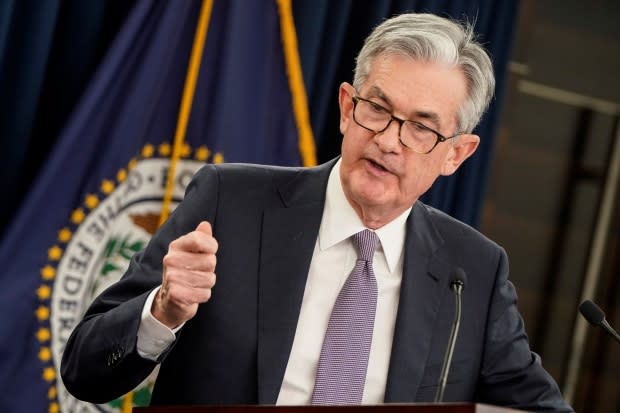Fed chair sees North America as an economic oasis in 2020: Don Pittis
A positive outlook for the North American economy means the U.S. Fed has largely taken rate cuts off the table in 2020. But for Canadians looking for new mortgages and renewals, the good news is that rate hikes are unlikely, too.
As usual, Federal Reserve chair Jerome Powell added the proviso that the central bank would not hesitate to stimulate the economy again if the U.S. were to be hit by an unpleasant economic surprise.
But unlike U.S. President Donald Trump and many market commentators, Powell and his advisers foresee no need for more interest rate cuts in the coming year. Effectively, Powell said, after successive cuts totalling three-quarters of a per cent, the central bank will now sit tight and wait for the effect of that stimulus to kick in.
"One thing that we're mindful of is that we've cut rates three times since July," Powell told a gathering of reporters at yesterday's monetary policy news conference. "And we do believe that monetary policy operates with long and variable lags, and that it will take some time before the full effects of those actions are seen in the economy."
Wait for the effect
Previous research has shown that while rate cuts have an immediate impact on stock and bond markets, their stimulus effect can take six months to a year to work their way into the wider economy. And like cannabis edibles, you don't want to have too many before you've seen the effect.
The group of bankers who participate in making the interest rate decision were not only confident in their outlook, dropping the word "uncertainties" from their statement, but in agreement, approving the policy unanimously.
One of the uncertainties that seems to be off the table is the North American trade agreement between Canada, the U.S. and Mexico — now revised with the support of Democrats — into what some are now calling NAFTA 2.1.
The final resolution of that agreement, which is expected to be ratified by Congress in the new year, secures Canada's close integration with what Powell sees as a strengthening U.S. economy.

While the percentage of Canadian jobless rose in the latest November figures, that could change if an apparent worker shortage in the U.S. continues to disseminate north across the border.
U.S. unemployment figures fell to 3.5 per cent the last time around and wage growth was well above inflation. As one report noted, the rate of wage increases outpaced the mortgage rate for the first time since 1972.
Powell expects unemployment to stay low and wage growth to stay relatively high.
Questioned as to why the low jobless rate and rising wages had not pushed inflation back up to the central bank's target of two per cent, Powell noted the weakening relationship between falling unemployment and rising inflation. He also seemed to say the official unemployment rate was an imperfect measure of how many workers were available to be enticed into the U.S. labour force.
Hidden slack
"Even though we're at 3½ per cent unemployment, there's actually more slack out there," said Powell, noting that the risk of keeping rates low to draw more people into the workforce is not something to be feared.
In fact, Powell once again said that a lack of inflation was a greater risk. In a circular phenomenon, he said, persistently low inflation led to low inflationary expectations, which led to lower inflation, and thus lower interest rates.
And persistently low rates make it impossible to stimulate the economy with cuts once a downturn comes.
Powell hopes to break that cycle.
As noted previously, Canada has a relatively healthy rate of inflation, though the statistics for calculating the Canadian core rate are different than those used by the Fed.
But one of the reasons sometimes given for Canada's higher inflation rate is that poorer people get a bigger slice of the income pie, meaning they spend instead of saving, helping to push prices higher.
For Canadian homeowners or those looking to buy, the prospect of U.S. interest rates remaining low may be reassuring, because no matter what the Bank of Canada does, five-year mortgage rates are heavily influenced by the U.S. central bank rate.

Trump may be disappointed that Powell did not add more stimulus, but the 2020 election may tie Powell's hands even further. By tradition, central bankers avoid hiking or cutting in the immediate run-up to an election on the grounds that they do not want to be seen as interfering in politics by boosting or weakening the economy in a way that may offer one party advantage.
Getting it wrong
Powell noted the positive effects of a North American trade deal in reducing investment uncertainty. He also implied that the greater danger for the U.S. economy was not the resolution of NAFTA 2.1, but the much more dangerous dispute between the biggest global trading powers: China and the U.S.
And the fact is that while it is reassuring that the team formulating yesterday's outlook were both unanimous and moderately optimistic, it is useful to recall that a year ago, the Fed got things quite wrong, as Powell described in his look-back at events of 2019, when it was forced to bail out an unexpectedly weak economy.
"Rather than modestly increasing the target rate for the federal funds rate this year, as seemed appropriate a year ago, we reduced it by three-quarters of a percentage point," he said.
While it may not have been intended that way, the description was a salutary reminder that no one — not even the U.S. Federal Reserve — can reliably predict the economic future.
Follow Don on Twitter @don_pittis


